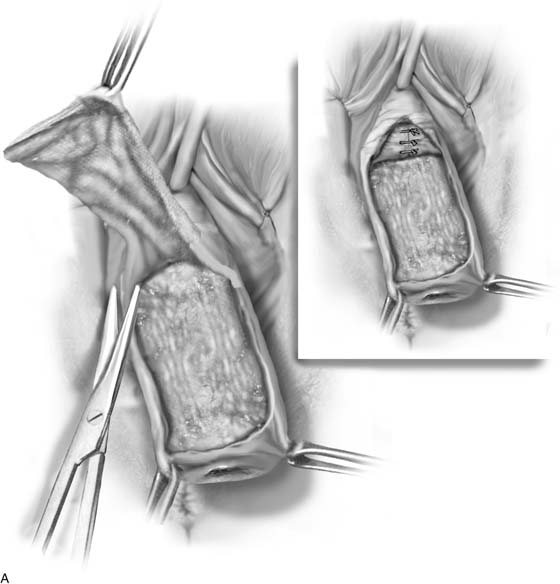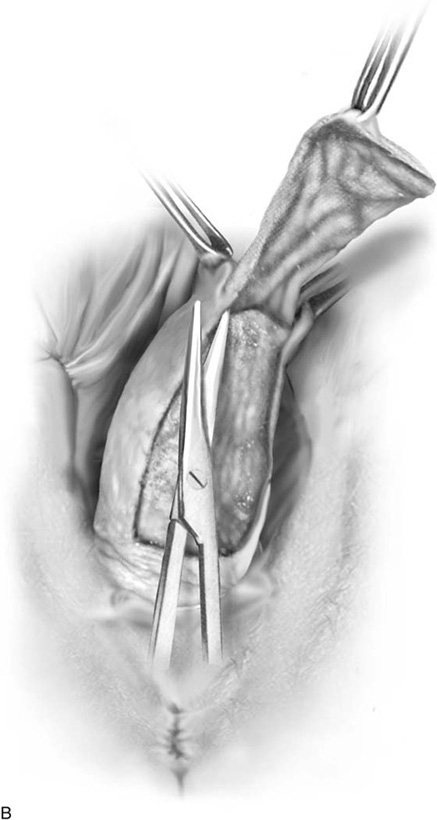Obliterative Procedure for the Correction of Pelvic Organ Prolapse
Obliterative Procedure
LeFort Partial Colpocleisis
In elderly, fragile, or medically compromised patients with advanced prolapse, the best management option is sometimes an obliterative procedure. The advantages of these procedures are that they can be performed quickly with minimal morbidity, often with the patient under a local anesthetic. When a uterus is present, a LeFort partial colpocleisis (Fig. 56–1) is performed as follows:
1. Traction is placed on the cervix to evert the vagina completely, and a 0.5% solution of lidocaine or bupivacaine (marcaine) with epinephrine is used to inject the vaginal tissue below the epithelium. A pudendal nerve block can be used if the procedure is being performed with the patient under local anesthetic. A Foley catheter with a 30-mL balloon is placed for easy identification of the bladder neck.
2. A dilatation and curettage should be performed if it was not performed preoperatively to ensure that no premalignant or malignant process is present in the uterus.
3. Areas to be denuded anteriorly and posteriorly are marked out with a scalpel or a marking pencil, as indicated in Figure 56–2. The rectangular piece of anterior vaginal wall should extend from 2 cm proximal to the tip of the cervix to approximately 5 cm below the external urethral meatus (see Fig. 56–2).
4. Sharp and blunt dissection is used to remove the vaginal epithelium. These flaps should be thin, leaving the maximum amount of fascia on the bladder and rectum. Sufficient vagina should be left bilaterally to form canals for draining cervical secretions or blood. We almost routinely perform a plication of the bladder neck (see Fig. 56–1). Posteriorly, the cul-de-sac peritoneum may be encountered when the vaginal mucosa is excised, but it does not have to be entered. Bleeding is controlled with fulguration. Absolute hemostasis is necessary to avoid a postoperative hematoma in the vaginal canal.
5. The cut edge of the anterior vaginal wall is sewn to the cut edge of the posterior vaginal wall with interrupted delayed absorbable sutures (Figs. 56–3 and 56–4). This is achieved in such a way that the knot is turned into and remains in the epithelium-lined tunnels that are created bilaterally (Fig. 56–5). Suturing in this way gradually pushes the uterus and the vaginal apex inward. When the entire vagina has been inverted, the superior and inferior margins over the rectangle can be sutured horizontally (Fig. 56–6).
6. Perineorrhaphy and distal levatorplasty is usually performed to increase posterior pelvic muscle support and narrow the introitus. Postoperatively, the patient is mobilized early; however, heavy lifting is avoided for at least 2 months to prevent recurrence of the prolapse secondary to breakdown of the repair. Figure 56–7 reviews the technique of LeFort partial colpocleisis with perineorrhaphy.
Colpectomy and Colpocleisis
In cases of posthysterectomy vaginal vault prolapse in which obliteration of the vagina is chosen as the procedure of choice, it is best to proceed with a colpectomy and complete colpocleisis. This operation is performed in cases of vault prolapse when operating time is best kept at a minimum and future vaginal intercourse is not anticipated. This procedure can also be performed with the patient under local anesthetic. The operation is performed by completely excising the vaginal mucosa from the underlying vaginal or endopelvic fascia. It is not necessary to enter the peritoneum. A series of purse string delayed absorbable sutures are placed, slowly inverting the vaginal muscularis and fascia (Figs. 56–8 through 56–20). Similar to the LeFort procedure, bladder neck plication and perineorrhaphy with levatorplasty are often performed with a colpectomy.









